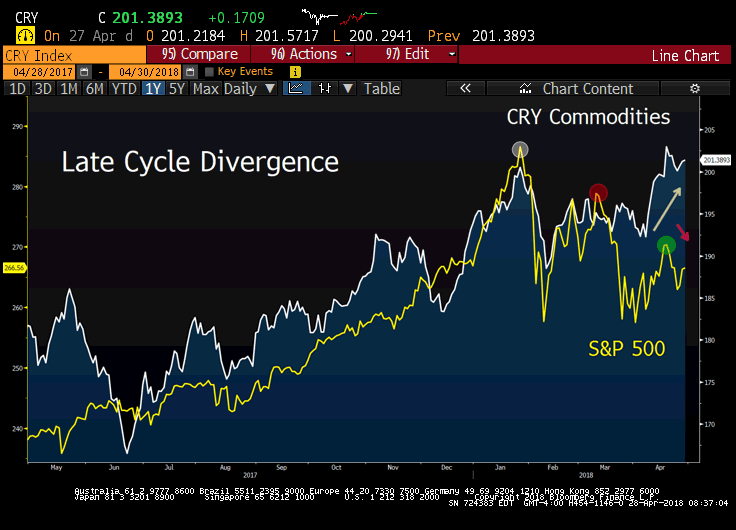Join our Larry McDonald on CNBC’s Trading Nation, Wednesday at 3:05pm ET
Pick up our latest report here:
Don’t miss our next trade idea. Get on the Bear Traps Report Today, click hereSince mid-December commodities are 10% higher with equities about 1% lower. We believe markets have entered a late cycle secular shift into a new regime.
Returns in 2018
Cocoa: +49.6%
Lumber: +27.3%
Wheat: +16.4%
Oil: +14.3%
Nickel: +12.1%
Corn: +11.5%
Soybeans: +10.8%
Aluminum: +6.2%
Nasdaq 100: +4.0%
Gold: +2.1%
Russell 2000: +1.3%
S&P 500: -0.10%
Dow Transports: -0.6%
Dow Jones IA: -1.6%
Copper: -7.2%
Bloomberg terminal data
Hot Commodities laying Pressure on Bonds
Monday the Fed’s preferred inflation gauge (PCE) is expected to hit the central bank’s 2 percent target for the first time in a very long time. Matching or exceeding that forecast would affirm traders’ conviction that inflation is headed higher, pushing up long-term yields.
Commodities Laying a Beating on Stocks in 2018
 “One of the side effects from the 2009-17 period of “global monetary radicalism” is found in the extreme financialization of the developed world’s economy. In the U.S., CFOs (corporate financial officers) have been incentivized to become financial engineers. In recent years, capital investment has been two standard deviations below previous economic recoveries. “Secular stagnation,” low growth rates, paltry interest rates, and worsening demographics, all favored an outperformance of “capital” over “labor.” In these periods, financial assets – like real estate, stocks, and bonds – outperform hard/soft assets like commodities. For U.S. companies, capital investment and other “real” economy-related risk-taking, offered very poor rates of return as the economy operated below its already low level of potential. To keep shareholders pacified, financial engineering through raising low-cost debt to fund share buybacks, ruled the land in recent years. Today, for the first time in nearly a decade, we have a sharp surge in fiscal spending, while the U.S. is operating above trend, and demand for labor (wages, capex) is picking up. Bottom line: we see a cyclical shift into a new regime. As central banks shrink their balance sheets, hard/soft asset (commodities) will outperform relative to overly expensive “financial assets.” This is a freight train coming at us – the only question remains – who’s getting on? We expect this under-loved asset class (commodities) to show leadership in the new regime. In our view, the global QE (asset purchases, quantitative easing, 2009-17) period marked the near term top of “financialization” and its gradual withdrawal into a late cycle landscape will lead to a “rebalancing” between cheaper commodity-related assets and overly expensive financial assets. The tipping point of this secular shift is the central bank taper and tightening process.”
“One of the side effects from the 2009-17 period of “global monetary radicalism” is found in the extreme financialization of the developed world’s economy. In the U.S., CFOs (corporate financial officers) have been incentivized to become financial engineers. In recent years, capital investment has been two standard deviations below previous economic recoveries. “Secular stagnation,” low growth rates, paltry interest rates, and worsening demographics, all favored an outperformance of “capital” over “labor.” In these periods, financial assets – like real estate, stocks, and bonds – outperform hard/soft assets like commodities. For U.S. companies, capital investment and other “real” economy-related risk-taking, offered very poor rates of return as the economy operated below its already low level of potential. To keep shareholders pacified, financial engineering through raising low-cost debt to fund share buybacks, ruled the land in recent years. Today, for the first time in nearly a decade, we have a sharp surge in fiscal spending, while the U.S. is operating above trend, and demand for labor (wages, capex) is picking up. Bottom line: we see a cyclical shift into a new regime. As central banks shrink their balance sheets, hard/soft asset (commodities) will outperform relative to overly expensive “financial assets.” This is a freight train coming at us – the only question remains – who’s getting on? We expect this under-loved asset class (commodities) to show leadership in the new regime. In our view, the global QE (asset purchases, quantitative easing, 2009-17) period marked the near term top of “financialization” and its gradual withdrawal into a late cycle landscape will lead to a “rebalancing” between cheaper commodity-related assets and overly expensive financial assets. The tipping point of this secular shift is the central bank taper and tightening process.”
The Bear Traps Report, February 10, 2018
Pick up our latest report here:
Don’t miss our next trade idea. Get on the Bear Traps Report Today, click here


